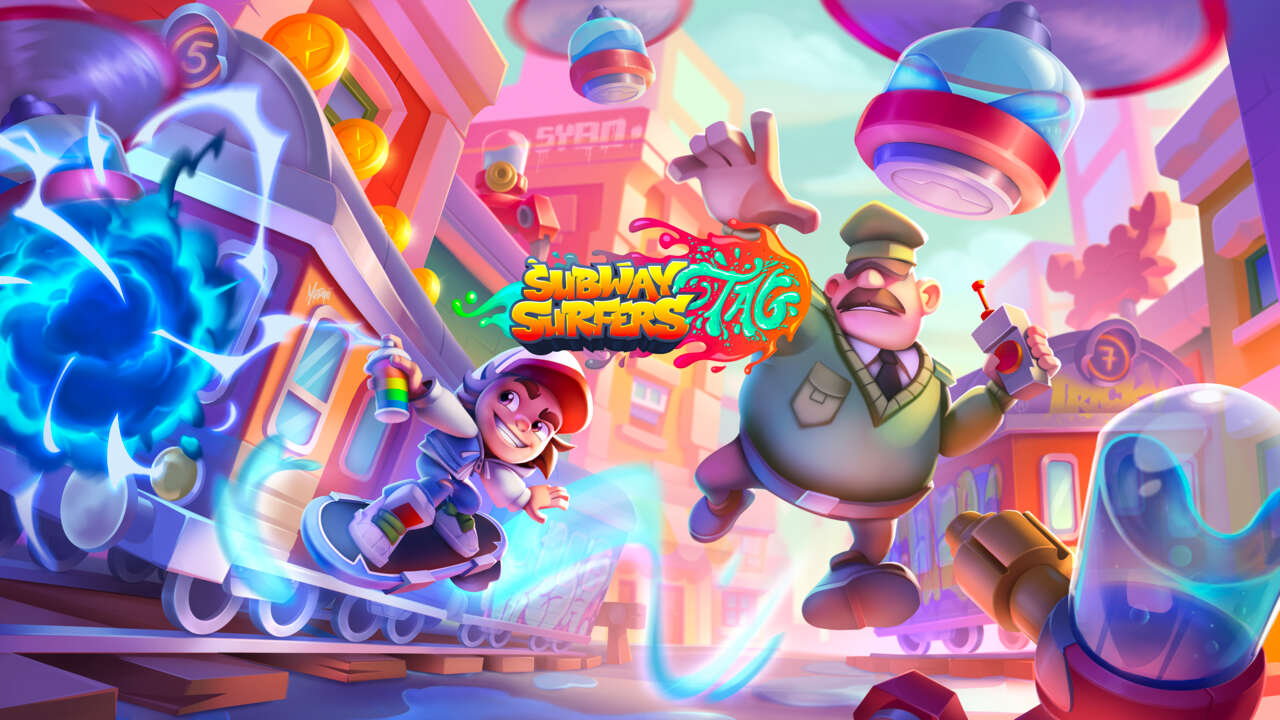Subway Surfers Creators On Making Its First Game Without Monetization
Sybo Games’ Subway Surfers is one of the biggest games in the mobile space. Along with having millions of players, Subway Surfers can also be seen in arcades and has received an animated adaptation on YouTube. For Sybo’s latest project, however, it eschewed the free-to-play formula that previously led the developer to success, for an Apple Arcade game based on its Subway Surfers intellectual property.
Subway Surfers Tag is not an endless runner like its predecessor, but rather an arena game in which you ride hoverboards around small levels, fighting robots and pulling off tricks to keep your board’s battery alive. GameSpot recently spoke with game director Eoin O’Doherty and Sybo CEO Mathias Gredal Nørvig about how this project came about, what it’s like to make a more traditional video game with an ending, what’s going on with the animated show’s 12th episode, and what it’s like to be part of a studio whose small game turns into a massive success.
GameSpot: Subway Surfers Tag is different than I expected. Why the departure from the core endless runner idea of Subway Surfers?
Nørvig: Very early on, before the original game was in development, the team made a Subway Surfers graduation movie from the animation workshop and they were still animators at heart. They liked the idea of creating compelling characters, deep universes, and trying things out. When they did their graduation movie, they weren’t thinking about games. They thought about the story and the universe. Then when the iPhone came out, they thought, “This is our platform. We can actually do something here that looks way nicer than what was available at the time.” And then when Temple Run came out in 2011, they thought, this is a perfect fit for what we created with our graduation movie. This actually fits the IP.
So, with Subway Surfers Tag, we want to allow players to enjoy the world of Subway Surfers, the universe, and the characters of the IP in many different ways. I’ll tell you in a second how they came up with the arena-style game, but basically from the get-go, we’ve never felt confined to just endless runners. We wanted to make more types of games in the IP because we know that there are so many fans around the world that enjoy it.
O’Doherty: I think one of the things we had to take into account was the IP itself and kind of what components go into the original game that players would know. We took a lot of those building blocks as kind of a baseline. We also looked at the constraints that Apple Arcade gives you because you have to build it for multiple platforms. The control scheme has to work across iPad, iPhone, and Apple TV and we want to make sure the experience is preserved across all the platforms, Mac OS included. With those kinds of elements, we did a lot of brainstorming and we looked into a lot of old-school games because we think Apple Arcade is a great platform for old-school arcade-style gameplay. We got inspired by a bunch of different games. Paper Boy was one of the first games we threw around. Picking up things and delivering them. We also looked at games like Tony Hawk[‘s Pro Skater] and Jet Set Radio.
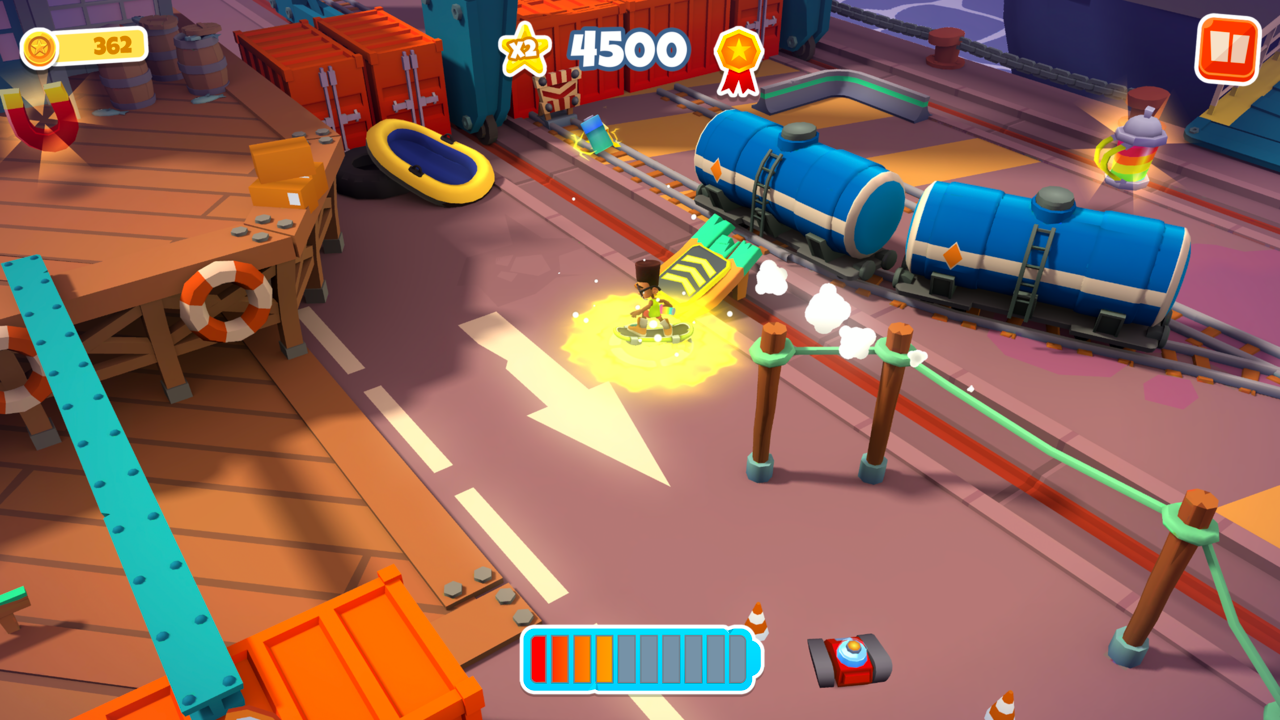
Coming into this, we felt like, this is the IP. We really like the autonomous movements of the surfers and we worked hard to keep that in some way, and then this idea of grinding and moving on things in a parkour nature came up. And that led us to, “Hey, why don’t we focus more on the hoverboard?” This is an element from the original game that you can activate, but we said, “Let’s put it in as a core element that you always start with,” and then we have this premise of the battery running out, which is different from the original game where if you lose it there, you keep running.
We just kind of ended the run at that point and with those building blocks, we just started going from there and adding more fun elements in, like different enemies and different spaces that these characters would go to, like the railyards, which is where the original game starts. But we wanted to imagine this big city–this big space, that the crew kind of hung out in all these different spots. Places like the mall, potentially at night when you shouldn’t be there, or maybe you should go to the park. The security guard would be there trying to stop you from doing what you’re doing and so that was kind of the where it all came from, but it was very bespoke.
We tried a lot of things and leaned in a lot of directions and eventually added a shooting mechanic, as well. We thought a lot about targeting. We thought a lot about the rhythm and made sure that it felt natural and considered what are you doing second-to-second in the game. A lot of this came together in an organic, kind of iterative manner over multiple playtest and months.
Did it start as an Apple Arcade game from the beginning? Or was it something you were already working on, and then the partnership came together with Apple?
Nørvig: I think that the best way to describe it is that we have been working on other game ideas and have been brainstorming what we could do. But then obviously we have a very close relationship with the other platforms and Apple has been a great supporter of Subway Surfers all throughout.
I visited Apple Park about three years ago and they said, “Look–we actually thought you came here to pitch an Apple Arcade game,” and I said, “Well, I’m not, but that sounds interesting. So let’s have that conversation.” That became the starting point and then as soon as the creative teams started rolling, it became a project that was targeting that platform.
We’ve been wanting to do something that fits the nature of the Apple Arcade that is family friendly, still has some edge, looks super-stunning graphically, and is just a great, fun, native experience on a mobile.
Was it a relief to make a game without having to think about monetization?
O’Doherty: It is very different. It feels very premium. It’s one of the reasons I think the team and I are enjoying the process of building a game for Arcade and why we started from scratch. We have our ideas in the background, but when you say you’re going to make something that’s going to be on a subscription service, all it has to do is engage the player, be fun, and have that IP representation. We started from that baseline. It’s not quite a relief, but it makes you think about things very differently. A lot of the teams I’ve been working with have mostly been free-to-play, but I’ve also had the luxury and privilege to work with Angry Birds, which is a very premium experience, so I kind of know IP-handling and that kind of thing. I took those lessons and reimagining them for Surfers on Arcade was a fun challenge–I’ll put it that way. The monetization aspect, while it is a great thing to think about–not having it there you realize, “Oh we have to do all these other things now, as well.” Like, you have to make sure the other tenets of gameplay really stand up. It made us really focus on gameplay and the user having fun and that’s a really good thing for a development team to be doing.
Nørvig: I think it also speaks to the quality of the teams. We are a profitable studio thanks to Subway Surfers, so it’s clear this was something we really just wanted to do. It’s been a lot of hard work from the team, but also a lot of support from Apple letting us take the time it needed to get to market because we wanted to make it right. We love our fans and the fact that we can now bring a curated, premium experience that actually supports our Subway Surfers world is perfect.
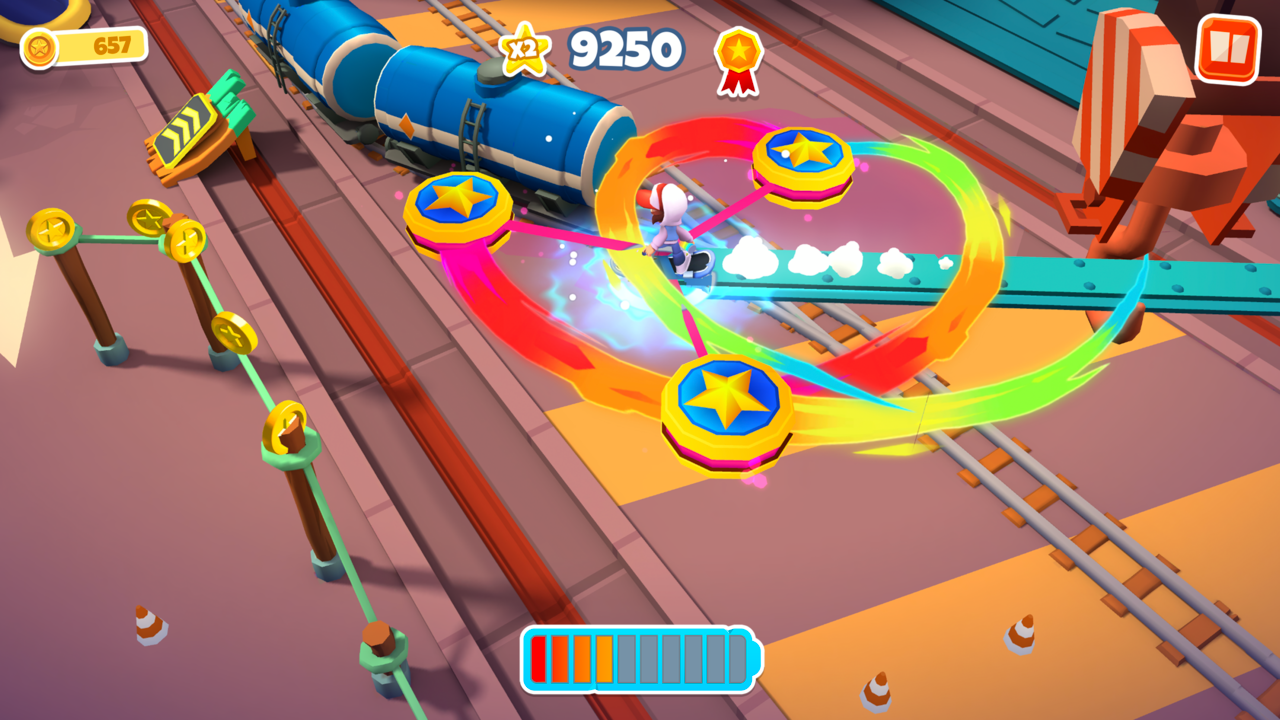
At the very beginning of the game, it starts as though you’re going to play the traditional endless runner Subway Surfers game, but it’s a fake out, and you’re dropped into a much different kind of experience. Can you explain the thought behind having that fake out in the beginning?
O’Doherty: We wouldn’t call it a fake out. We’d call it familiar, but fresh. We wanted to make sure you knew the gameplay was different. We knew a big thing was probably the camera angle shift was going to be one of the most noticeable differences. We tried a few different things to on-board the player and we felt traversing from what players already knew, which is running through the train and the rails, and having a kind of a narrative moment would bring you into the new game. We felt it was more of a natural way to say, “Okay, you know this game. But actually, we’re moving it.”
That is when the camera pans up and it all moves into this kind of arena zone. That intro was a good way to teach the game. We actually, originally, had a much, much more tutorialized first section that we decided to remove because putting the player in the arena and giving them control right away just worked better.
We have a lot of elements of that idea, familiar, but fresh, like reimagining the power ups you can find from the original game. Different types of grid systems that come from the classic game are represented in this, as well. So familiar, but fresh is exactly how we tried to focus on for all of the elements, including the introduction and the home screen–giving you the idea that this is Subway Surfers, but it’s also a little bit different. So, that was the reason for that intro.
Nørvig: I think it also speaks to the creative development because we’ve also gotten to know the IP even better through the game development. Every now and then there would be challenges from the team saying, “Well, could this be in software?” Or, “Hey, there are these aspects of Subway Surfers… how would that fit into this type of gameplay?” We tried a ton of different enemies, a ton of different mechanics or aspects of the environment that would fit the IP, some that felt counter to the IP, and we sort of swung back and forth to find where the game ended.
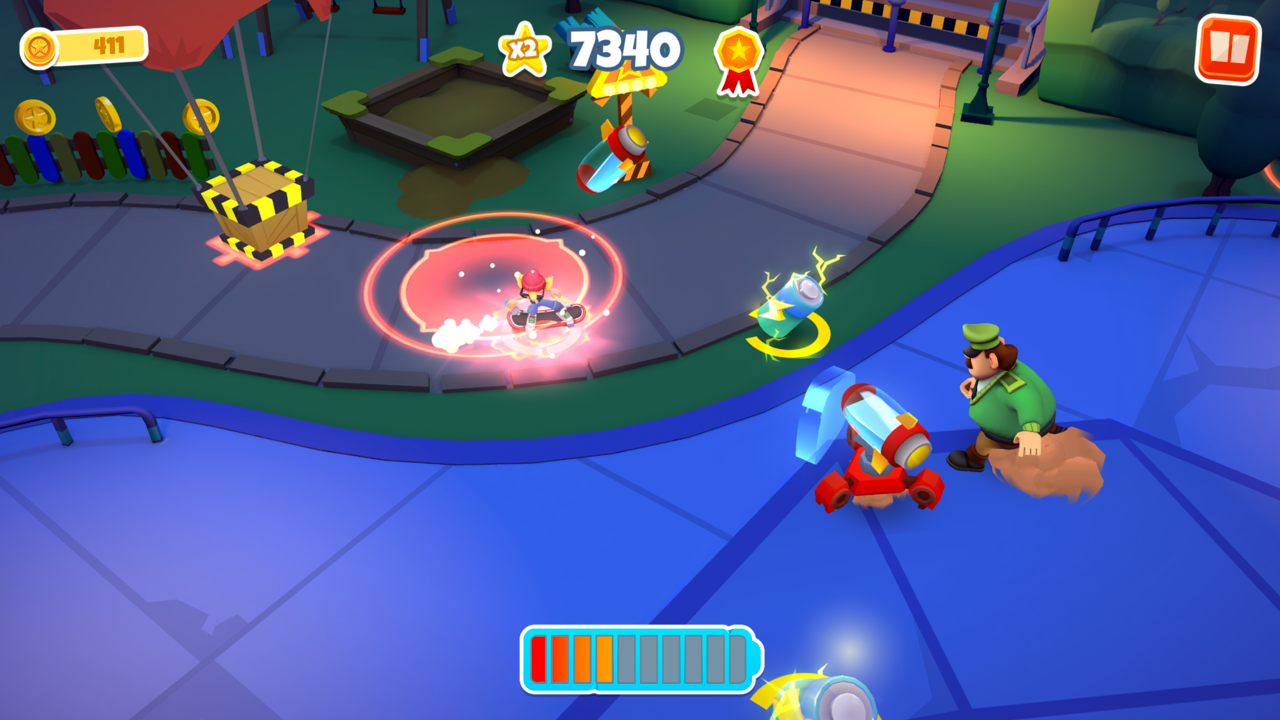
I haven’t played enough to answer this question myself, but is there an ending?
O’Doherty: There are goals you can complete. The core progression track of the game is essentially unlocking different arenas by hitting high score milestones in the previous arenas. And so we have four of them at launch and more potentially to come. But once you complete all those arenas, there are some upgrades you acquire, you can use coins to get more powerful, and you can get more points from that, as well. And then you’ve got your ultimate high score at each of the arenas, which is something Subway Surfers is known for–getting a high score. Players who are really engaged can continue to play in those arenas and challenge themselves against their friends’ scores. You can really get to know the rhythm of the arena, really know how to maximize the second to second gameplay in order to get the best score you possibly can. But in terms of an ending, there is a certain amount of content that you can unlock, but you can always get a higher score.
Was it weird to make a game with at least some kind of conclusion?
O’Doherty: I don’t think we thought about it that way. Subway Surfers is an endless runner, right? It just has a kind of structure to the game that’s very clear and conditional. We wanted to preserve some of that. We have the guard there if he catches you and you run, but what we noticed when we started this idea is, what would you say about the city? How do we explain all these locations in the city? At one point we thought maybe we’ll do it on one big map, but we felt that was too sprawling and it wasn’t really going to really give the player a clear sense of their space and where they are. So, we ended up deciding to break that into smaller parts and that’s where we ended up having this arena concept so we could observe all these different locations without it having them all be knitted together. That’s kind of why we went with the arena structure, but I never had it set in my mind to say, “Oh, there has to be an ending to this game.”
Subway Surfers Tag’s art style is different from Subway Surfers. Was that change a complicated process or was it easy to take the established look and do something a little bit different with it?
Nørvig: We’ve continuously developed the art style internally because we’ve tried applying it to mini figurines and making aged up versions of the characters. We’ve tried different things for various licensing efforts. So all throughout, we’ve had a lot of creatives on our side that have been eager to explore the elasticity of the IP. What can it look like? What would they look like in this setting? What would the whole crew look like in this setting? So from that point of view, I think it was a pleasure for the team to work on, but as I said, there was also a learning curve because getting to know the IP in a different context or in a different setting–like the arena brawler–that’s different because you have to read the character in a different way depending on how they’re controlled. For a runner you need big shoes and you need to be able to see where they run. In an arena game with an overhead view, you need different readability. The team was actually really enjoying getting to know the IP. It also came with some a-ha! Moments where they actually gave new details back to the main game team saying, “This is also what the IP can be.”
Speaking of taking the IP in different directions, what is happening with the Subway Surfers animated show?
Nørvig: We have 11 episodes live on YouTube and we know that our fans love them. I think we’ve seen a lot of questions coming about the 12th episode. It’s not something we’ve put in the icebox, but it’s also not something we’re actively working on. Right now our focus is giving the players more game experiences, but we definitely have it on the roadmap ahead of us that we want to do more animated content.
O’Doherty: To comment on that as well, the animated series is something we draw from internally. It’s a great way to think of the worlds that we already have and we’re building. The Delorean park that’s in the show is also represented very clearly in Subway Surfers Tag, and also the railyard where the original crew hangs out is represented in the game, as well. We draw from that series quite a lot and try to round it out in a games experience. We took a lot of inspiration from the show internally to make sure that we could have cool locations that continue the narrative in the game.
Is there room in the mobile market right now for premium mobile games that you pay for once and can complete? That sort of game seems to exist less in the mobile market. Is that a mistake? Do you think that kind of games could come back?
Nørvig: I think if you look at it from an industry-wide perspective, free-to-play is obviously winning because it is the biggest part of the market and it grows the fastest. We are in free-to-play because we believe we can reach a lot of players and we can give a lot of great experiences to players through the free-to-play business model.
But if you look at the premium market, I actually don’t think it shrunk. It just represents a smaller fraction of the overall market size. I think there’s still a lot of players that enjoy a good premium experience and enjoy the different types of game design you can make when it doesn’t have to have the free-to-play mechanics. I think there’s definitely room for it and I think platforms like Apple Arcade, and some of its competitors, that curate content and make sure that there’s family friendly, safe havens where kids and people who just want to have a monthly subscription can enjoy the experiences without having to worry about monetization are a really solid supplement to what free-to-play allows you to try for free. And then if you want to, you can dive deeper.
O’Doherty: Ditto. I came from the original premium side of mobile’s early days. It’s an organic path that I think that the industry has moved down into where free-to-play is dominant for lots of reasons. Mostly that free-to-play games are accessible and help for getting your name out there. But like a pendulum, I think things go back and forth. I think whenever there’s any part of any industry that’s underserved, something will step in to try and serve that. I don’t know if there’s a shift or a wave coming, but I wouldn’t be surprised in the future for a game or two that can crack that and really break through and become a hit, even with a premium price tag. We’ve seen games like that in the past, right? Fall Guys, for example. Is it possible as a full trend? I don’t know. It’s impossible to say, but I wish those studios very good luck and I’d love to play the games when they make them.
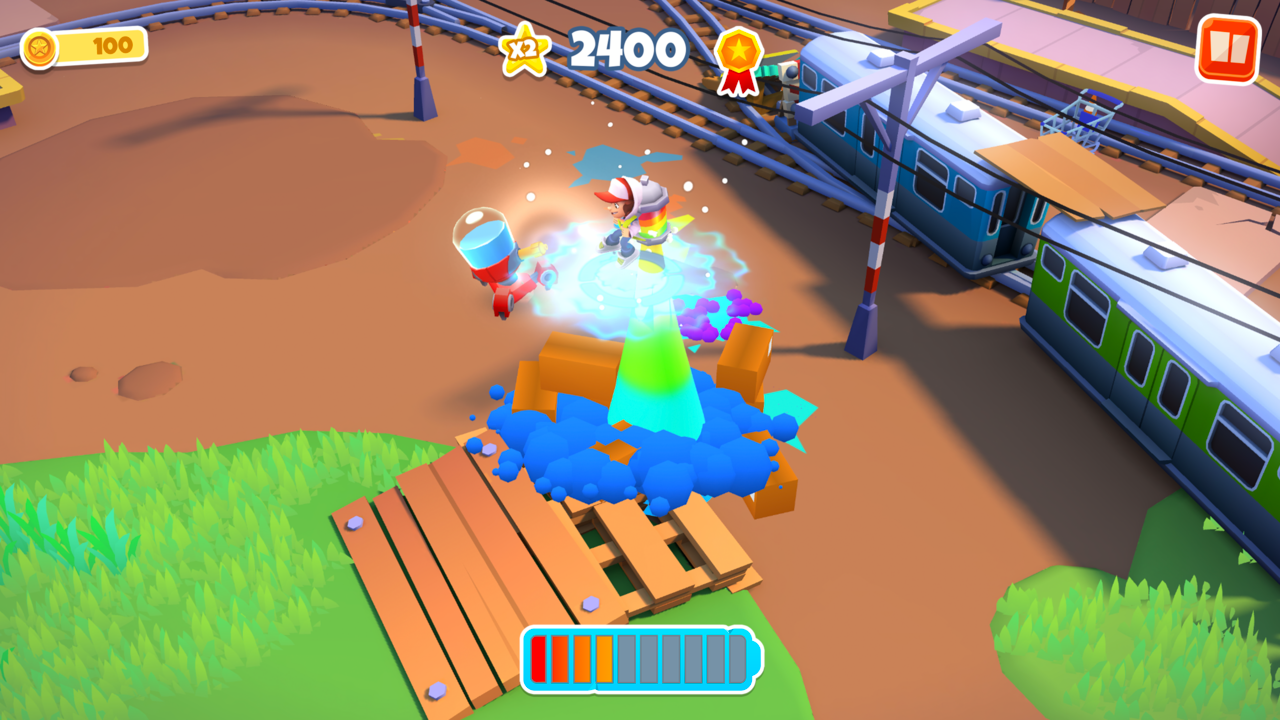
Gallery
Looking at the long-term trajectory of Sybo, I want to know about the point where it was clear that Subway Surfers was a massive hit. Was there a switch that happened at Sybo when that happened?
Nørvig: I knew one of the founders from childhood, so I knew him when it happened, but I hadn’t started consulting with the company yet. I started about nine months after. But basically it was right at launch. This was May 2012, so very early days in the mobile space, but three days after it launched they had the first million downloads. That was a number that anyone dreamt of getting in total downloads over the lifespan of a game at that time. The fact that everyone downloaded Subway Surfers became the kickstart for everything Sybo became since. That trajectory has continued and we’re still having more than a million and a half daily new installs, and that’s ten years past launch. That’s the momentum that we have from having such a solid IP, but also being one of the first comers to the market means we have this mobile evergreen status that still gives us a lot of organic traffic because people love what we’re doing. And I think they can see that we also love them. We interact with them on Discord, we reach out on social media, we have a lot of virality and campaigns that speak to the love of the IP and our love for the game.
I am sure this is something Sybo sits around and ponders a lot, but why did that happen? Have you overanalyzed it to try to figure out why Subway Surfers was instantly such a big hit?
Nørvig: I’m an economist by trade, so I can explain half. The other half is serendipity, right? A lot of Subway Surfers’ appeal comes from the completely self-explanatory pick up and play niceness of it. It’s totally intuitive that this is how I play a runner and Bodie Jahn-Mulliner (president & co-founder) and Sylvester Rishøj Jensen (chief creative director) came up with it. Before you would tilt the screen. The three-lane mechanic and the swipes was Subway Surfers in 2012 and every runner since that has copied the formula.
Then, of course, the art style meant that we had a lot of virality and word of mouth coming from over-the-shoulder recognizability. If you pass Subway Surfers, even though we’ve visited more than 50 cities on our world tour, you can still recognize Subway Surfers. You’re playing in a completely different part of the world, but still, people know this is a Subway Surfers. I think those two elements are definitely part of it. And then the final part, I would say, is the thoroughness and the quality we put into animation. Even early in development, we were always over-invested in making things look really nice. The tactility and sensibility of the movement and that it’s actually done by skaters from the world of underground culture and subculture of hip hop street graffiti means we have a lot of people that praise us for doing something that just looks better.
Even when new games come out that try to compete with us–and we wish them all the best–we can see they don’t spend as much time with the final milliseconds of gameplay. Our moment to moment gameplay is second-to-none.
Subway Surfers Tag is available now exclusively on Apple Arcade.
The products discussed here were independently chosen by our editors.
GameSpot may get a share of the revenue if you buy anything featured on our site.
For all the latest Games News Click Here
For the latest news and updates, follow us on Google News.

